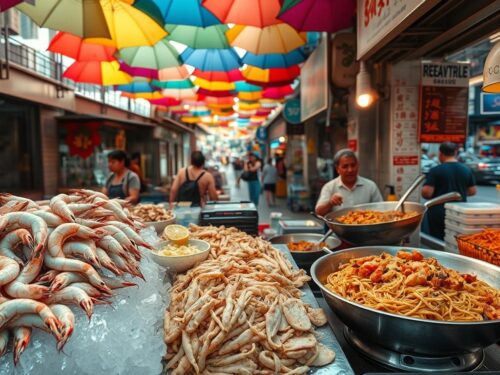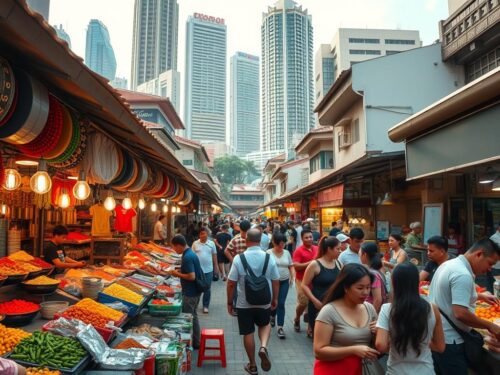Singapore’s dining scene is a melting pot of flavors, and Peranakan cuisine stands out as a cultural gem. This unique blend of Chinese and Malay traditions creates dishes bursting with bold spices and rich heritage. From fragrant curries to colorful kueh, every bite tells a story.
Our curated list celebrates both time-honored recipes and modern twists. Whether you crave a Michelin-starred feast or a cozy shophouse meal, there’s something for every palate. Many spots use family recipes passed down for generations, ensuring authenticity in every dish.
Looking for a quick lunch or a lavish dinner? Explore our top picks for an unforgettable dining experience. For more local flavors, check out our ultimate dining guide.
Key Takeaways
- Peranakan food blends Chinese and Malay culinary traditions.
- Options range from high-end venues to hidden home-style eateries.
- Family recipes keep flavors authentic and rich in heritage.
- Dishes feature bold spices and vibrant colors.
- Perfect for business lunches or leisurely dinners.
1. Discover the Best Peranakan Restaurant Singapore Has to Offer
Joo Chiat’s colorful shophouses hide culinary treasures rooted in centuries-old traditions. This vibrant district, along with Katong, forms the heart of Peranakan food, where wok-fired noodles share the table with coconut-rich curries.
What sets this cuisine apart? Think Chinese stir-fry techniques layered with Malay spices like turmeric and Indonesian ingredients such as tamarind. Dishes like ayam buah keluak—a complex chicken stew with black nuts—tell stories of migration and adaptation.
Modern chefs honor heritage while adding creative twists. Some reinterpret classics with sous-vide meats or artful plating, while others stick to time-tested claypot methods. The result? A dining experience that feels both nostalgic and fresh.
Beyond restaurants, intimate home kitchens now offer private feasts. Hosts serve heirloom recipes on antique porcelain, turning meals into immersive cultural journeys. It’s a trend that’s gaining fans among locals and travelers alike.
2. Pangium: Contemporary Straits Cuisine by Chef Malcolm Lee
Michelin-starred Chef Malcolm Lee brings bold *flavours* to Pangium’s *menu*. A partnership with COMO Group, this spot near Botanic Gardens reimagines heritage dishes with avant-garde techniques. Think deconstructed *tau yu bak* with sea cucumber or pork jowl—each plate tells a story.
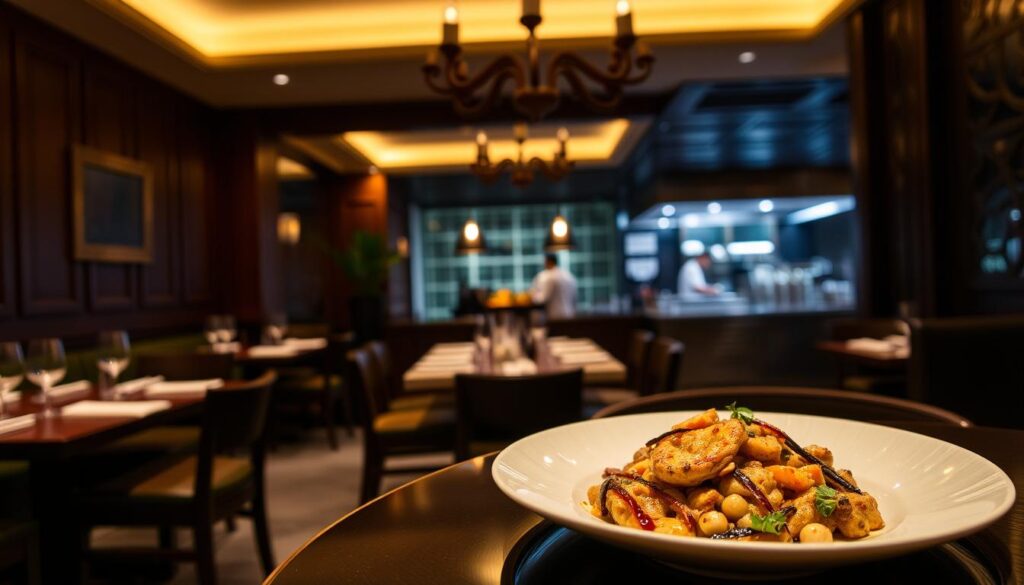
Signature Dishes to Try
Their *signature* pang susi swaps traditional pastry for a buttery bolo bun crust. The *wagyu beef* rendang, slow-cooked with coconut milk, melts tenderly. For vegetarians, tea tree mushroom fritters offer a crispy alternative.
A reinvented *buah keluak* paste elevates the nasi ulam pairing. Chef Lee’s playful twists honor tradition while surprising the palate.
Ambiance and Location
Floor-to-ceiling windows frame Botanic Gardens’ greenery, blending biophilic design with intimate dining. Neutral tones and rattan accents create a serene backdrop for the vibrant *menu*.
Ideal for leisurely lunches or romantic dinners, Pangium turns meals into multisensory experiences. Reservations book fast—plan ahead.
3. Rempapa: A Multicultural Peranakan Experience
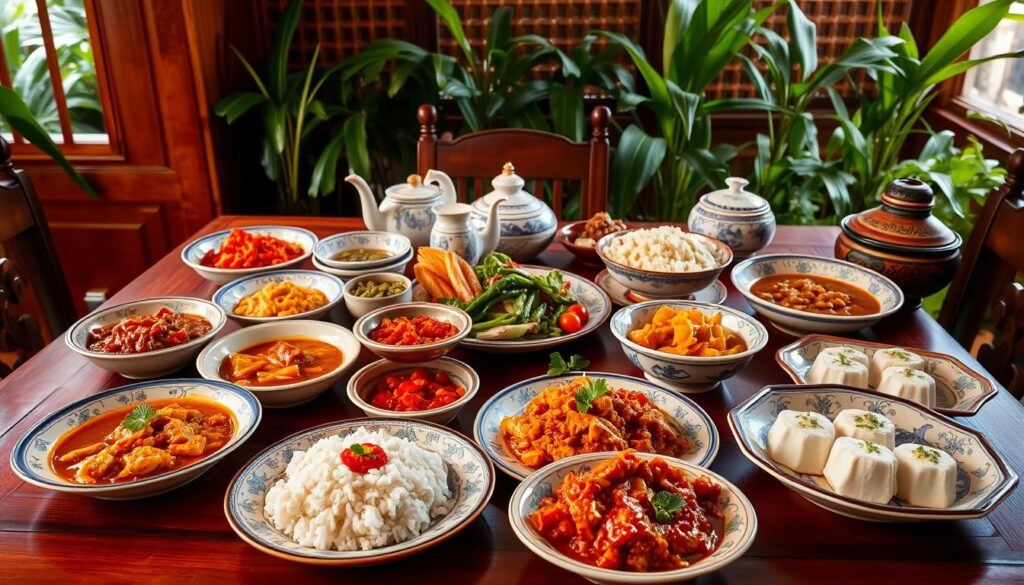
At Rempapa, culinary boundaries blur as Chef Damian D’Silva redefines heritage with bold fusions. This lively eatery bridges Sri Lankan, Malay, and Chinese flavors, serving brunch to late-night dinner with equal flair.
Chef Damian D’Silva’s Heritage Recipes
The chef’s rebel spirit shines in 100-year-old recipes like babi pongteh, a tender pork stew simmered in fermented soybean paste. His Sri Lankan chicken curry bursts with tangy tomato chutney—a nod to his multicultural roots.
Must-Order Dishes
Share the fiery king prawn sambal, where plump seafood meets house-made chili paste. For a family-friendly bite, crispy Hakka fried pork delivers crunch without the guilt.
Pair these dishes with local craft beers for a modern twist. Rempapa proves tradition can taste thrillingly new.
4. Godmama: Comfort Food with a Modern Twist
Three passionate co-owners bring their grandmothers’ kitchen secrets to life at Godmama. This lively spot blends *tradition* with creativity, serving dishes that feel both familiar and fresh. Their shared love for *family* recipes shines in every bite.
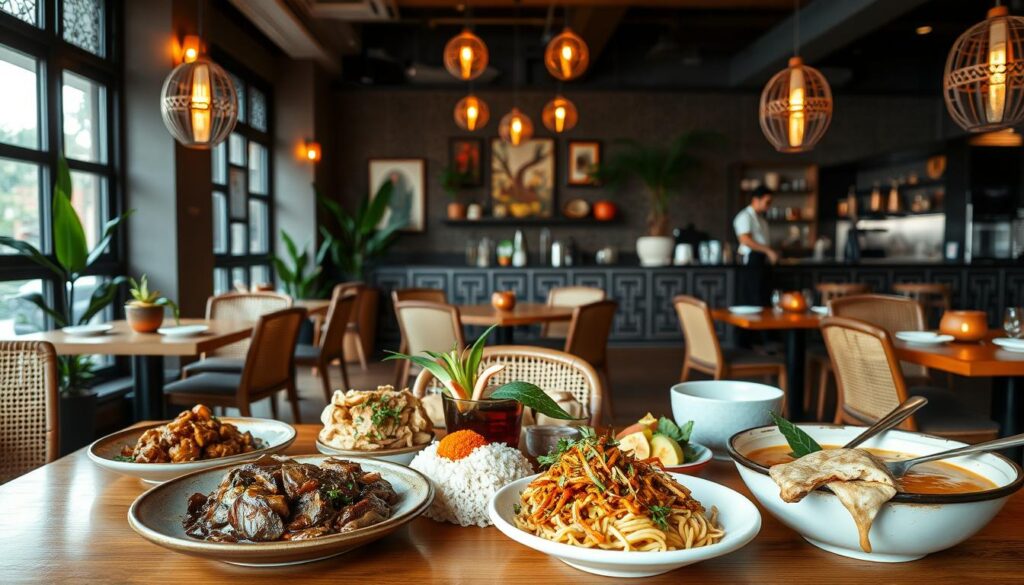
Family Recipes and Stories
Christina Keilthy’s delicate egg skin popiah wraps crunchy jicama and prawns—a tribute to her childhood. The *ayam buah keluak* simmers for hours, unlocking the black nuts’ earthy depth. Each dish tells a story of generations.
Weekend Brunch Highlights
Brunch here is anything but ordinary. Try the *buah keluak bolognese*, where Italian pasta meets Peranakan spices. The *otak otak Benedict* swaps English muffins for spiced fish cakes, drizzled with sambal hollandaise.
| Dish | Twist | Perfect Pairing |
|---|---|---|
| Butterfly Pea Flower Rice | Vibrant blue hue, coconut-infused | Homemade sambal |
| Pengat Buttermilk Pancakes | Banana custard, gula melaka syrup | Kopi tarik |
Don’t leave without grabbing a jar of their fiery sambal. It’s the perfect way to bring this *meal* experience home.
5. Bonding Kitchen: Hearty Nonya Grub in Orchard
From humble Malaysian roots to Orchard Gateway, Bonding Kitchen celebrates Nonya traditions. Chef Danny Chew’s restaurant began as a pandemic passion project, blending home-style warmth with premium ingredients. Every dish here tells a story of heritage and hustle.
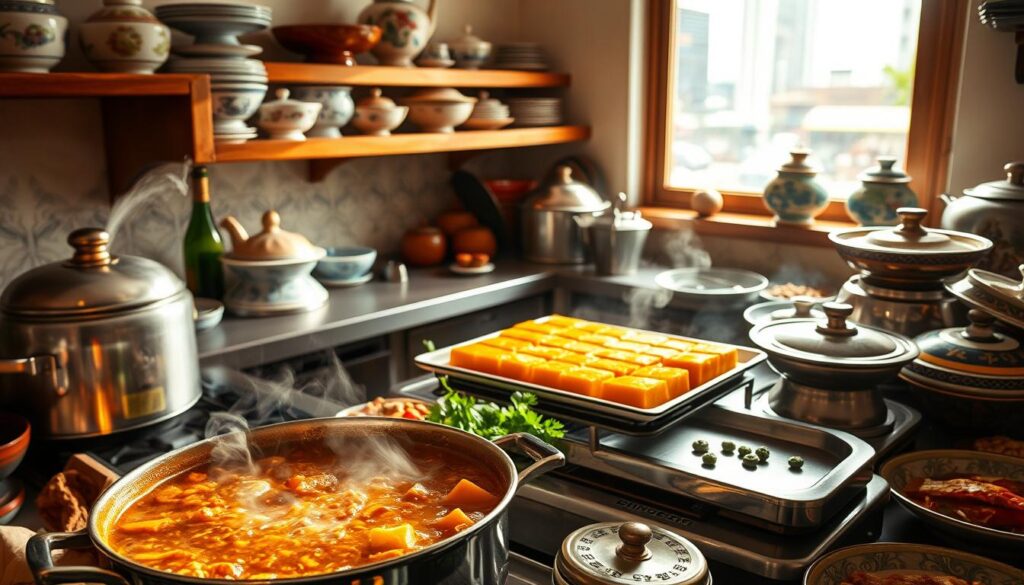
Homemade Kueh Pie Tee and Wagyu Beef Rendang
Their *kueh pie tee* shells are handcrafted into delicate top hats, filled with crunchy jicama and prawns. The labor-intensive process ensures each bite stays crisp, just like grandma’s recipe.
For meat lovers, the *wagyu beef rendang* steals the show. Marbled rib meat simmers for hours with toasted coconut, creating deep, smoky flavours. Pair it with *buah keluak fried rice* for a full-bodied feast.
Chef Danny Chew’s Vision
Raised in a Segamat kampung, Chef Danny grew up surrounded by Nonya dishes. His 10-hour *pong tauhu soup* reflects this patience—a clear broth brimming with tender tofu and mushrooms.
“Food should connect people,” he says. From private dining origins to Orchard’s lively scene, Bonding Kitchen lives this ethos. Dive into modern Peranakan food that honors tradition while embracing innovation.
6. Violet Oon Singapore: A Tribute to Colonial Flavors
Step into Violet Oon’s world, where colonial elegance meets vibrant Peranakan flavors. This iconic restaurant, nestled in the National Gallery, pays homage to Singapore’s multicultural heritage through time-honored recipes and artful presentations.
Iconic Dishes Like Ayam Buah Keluak
The ayam buah keluak here is legendary—slow-cooked chicken steeped in earthy black nut paste, served with fluffy rice. Another standout? The dry laksa, where springy noodles cling to a rich, coconutty rempah paste.
Colonial-era dishes like Hainanese pork chops and mulligatawny soup share the menu, each reinterpreted with Violet’s signature flair. Don’t miss the pineapple tarts, balancing buttery crust with tangy-sweet filling.
Retail Section for Takeaway Goodies
Before leaving, browse the Insta-worthy retail corner. Jarred sambals, spiced cashew cookies, and vibrant kueh make perfect edible souvenirs. The cake counter’s intricate creations—like gula melaka chiffon—are almost too pretty to eat.
Violet Oon isn’t just a meal; it’s a delicious dive into Singapore’s layered history. Reservations recommended—this gem draws crowds for good reason.
7. Candlenut: Michelin-Starred Peranakan Dining
Dempsey Hill’s lush greenery sets the stage for Candlenut’s groundbreaking Peranakan cuisine experience. As Singapore’s first Michelin-starred establishment specializing in this heritage fare, Chef Malcolm Lee’s kitchen blends ancestral techniques with contemporary flair. The result? A dinner that feels both museum-worthy and deeply personal.
Ahmasake Menu Highlights
Their signature ahmasake (Peranakan omakase) menu surprises with cross-cultural creations. Japanese hamachi tartare gets a local twist in kueh pie tee shells, topped with torch-grilled bonito flakes. The buah keluak risotto swaps Arborio rice for forbidden black rice, simmered in a rich nut paste emulsion.
Seasonal ingredients dictate the tasting journey. One night might feature blue swim crab with young coconut, while another highlights wild-caught prawns in lemongrass foam. Each course arrives like edible storytelling.
Premium Ingredients and Techniques
Chef Lee sources wagyu beef from Hyogo for his rendang, slow-cooked with 15 spices until fork-tender. Even pantry staples get upgrades—homemade belacan uses sustainably harvested shrimp, aged for six months.
The COMO Dempsey location enhances the experience. Diners savor these creations under swaying frangipani trees, where colonial architecture meets modern culinary artistry. Reservations here aren’t just meals—they’re masterclasses in heritage innovation.
8. The Blue Ginger Restaurant: CBD’s Peranakan Gem
Tucked between skyscrapers, The Blue Ginger offers a taste of heritage in Singapore’s bustling CBD. This restaurant blends tradition with convenience, serving office workers and curious foodies alike.
Ngoh Hiang and Otah-Otah Standouts
Start with their crispy ngoh hiang—five-spice pork rolls wrapped in bean curd skin. The dishes shine with a crunchy exterior and juicy filling, perfect for sharing.
Otah-otah arrives in banana-leaf parcels, steaming with lemongrass-infused fish paste. Moderated spice levels cater to international palates while keeping flavors vibrant.
Ideal for Business Lunches
Efficient service makes this a top lunch spot for time-crunched professionals. Set menus rotate weekly, featuring classics like ayam buah keluak or vegetarian laksa.
Just 3 minutes from Tanjong Pagar MRT, it’s a seamless dining escape between meetings. Come hungry, leave with a newfound love for Peranakan fare.
9. Private Peranakan Dining Experiences
Behind unassuming shophouse doors lie culinary secrets passed through generations. These exclusive feasts offer what restaurants can’t replicate—the warmth of a family kitchen and heirloom recipes served on century-old china.
Rumah Baba Fred’s Shophouse Feasts
Geylang’s vibrant colors fade as you enter Baba Fred’s 1920s shophouse. The 10-course dining experience begins with petai prawns—stink beans caramelized with belacan and served in coconut shells.
Antique cabinets display blue-white porcelain while guests share stories at the communal table. “Every dish carries my grandmother’s fingerprints,” says host Fred Lim, pointing to handwritten notes in his heritage cookbook.
Nonya Bong’s Rare Recipes
Chef Jeffrey Chia’s hati babi bungkus reveals why his waitlist stretches months. The labor-intensive pork liver parcel, wrapped in caul fat and steamed in pandan, showcases 68 years of culinary mastery.
Unlike restaurant menus, these dishes change with lunar cycles and family traditions. A single meal might include Nyonya laksa from Malacca and Kelantan-style gulai tempoyak, each with its own migration story.
The true magic happens after dessert. Hosts often share photo albums and kitchen tools, turning meals into living dining experiences that linger in memory longer than any spice.
10. Conclusion: Savoring Singapore’s Peranakan Heritage
From Michelin-starred kitchens to hidden home dining, Peranakan cuisine offers endless ways to explore Singapore’s rich culture. Each bite tells a story of tradition, innovation, and bold flavors.
Venture beyond tourist hotspots to discover rising chefs and family-run gems. Pair meals with visits to Joo Chiat’s heritage shophouses for a full sensory journey.
Whether craving street food or fine dining, every dining experience adds a new layer to this culinary adventure. Try multiple spots to taste the full spectrum of flavors.
Let these vibrant dishes connect you to Singapore’s living heritage. The table is set—your flavorful exploration awaits.


